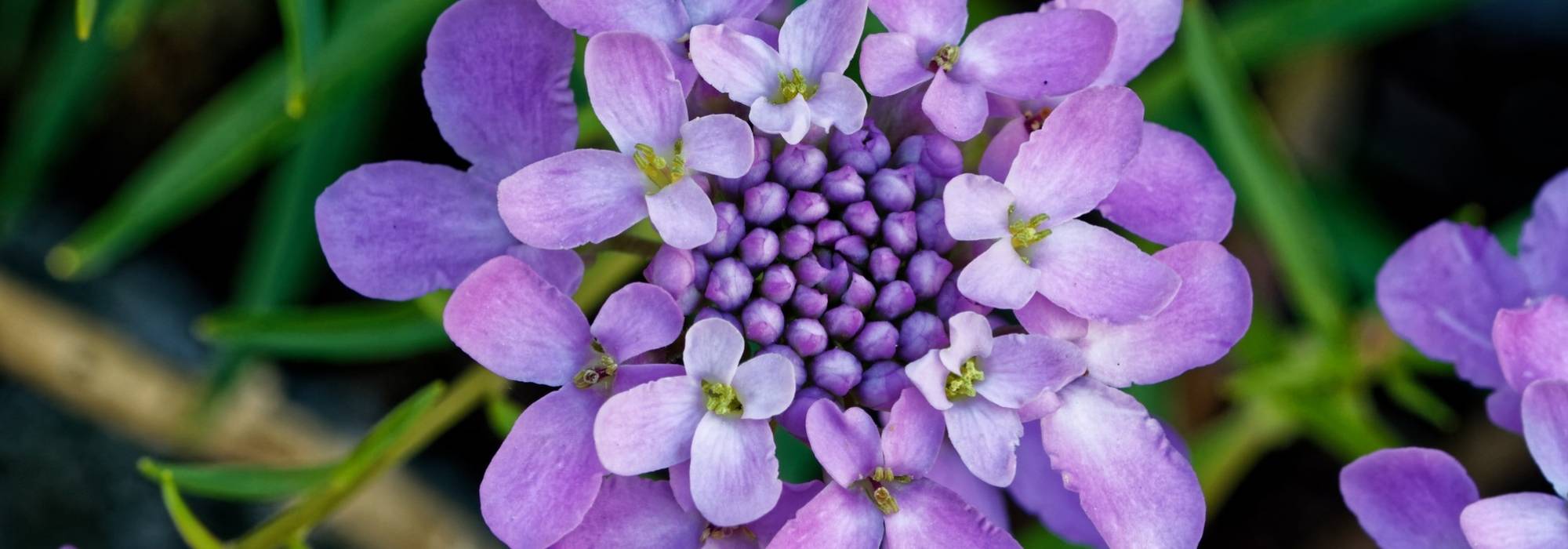
Iberis, Iberis sempervirens: planting, sowing and care
Contents
Iberis in a nutshell
- Iberis or candytuft are hardy, evergreen perennial ground covers
- At the very beginning of spring, they are covered in white, pink, mauve, or purple flowering
- Unfussy, Iberis thrive in arid and challenging spots throughout the year
- Thsalpi is ideal for slopes, borders, or trailing over a wall or planter
- The abundant flowering is melliferous
A word from our expert
Iberis, also known as candytuft or thsalpi, is very popular in dry gardens, and for good reason: they bloom generously in spring and, thanks to their evergreen foliage, they are present all year round. They require no special care and are hardy. It is an ideal plant for beginners or for gardeners with little time to devote to their garden.
Candytufts bring a Mediterranean touch as they trail over a wall or edge a path with brilliance and freshness. Sun-baked slopes find in Iberis a shrub that can effortlessly cover them in all seasons. These evergreen cushions are perfect for a classic border or, conversely, languidly nestled between the slabs of a sunny terrace.
Whether in dry gardens, beginner gardens, a balcony to green up, or a garden without a gardener, carefree plants, candytufts will settle anywhere there is sunshine!
Description and use
Botanical data
- Latin name Iberis
- Family Brassicaceae
- Common name iberis, basket of silver, thsalpi, stool
- Flowering April to August
- Height 15 to 30 cm
- Exposure full sun
- Soil type light and well-drained soil
- Hardiness -15°C
Iberis is a genus native to the Mediterranean and includes around fifty species. They are commonly known as basket of silver, thsalpis, stools, iberids… These are more or less woody spreading perennials like Iberis sempervirens or annuals like Iberis umbellata. Iberis belongs to the Brassicaceae family, formerly known as Cruciferae, which includes cabbage, the money plant…
These perennials have a spreading tuft and irregularly rounded shape and feature small, leathery, glossy lanceolate leaves. They are numerous and closely spaced, and their green, satin-like colour particularly highlights the clusters of tiny white flowers, sometimes pink like the variety I. sempervirens ‘Pink Ice’ or purple (the first cultivar being I.sempervirens ‘Absolutely Amethyst’) that appear in spring.
The characteristic flowers of the Brassicaceae are formed of 4 petals arranged in a cross, enhanced by 6 golden stamens. Iberis has a small peculiarity, as two of the four petals are slightly larger. They are particularly melliferous and delight pollinating insects. They are gathered in opulent corymbs and produce indehiscent fruits, siliquae, typical of the family.
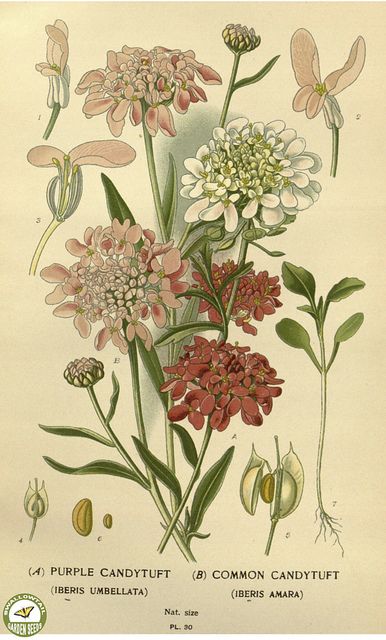
Iberis umbellata and Iberis amara – botanical illustration
Given its small size, its flowering is spectacular and this is what makes the glory of the baskets of silver. Moreover, maintenance is reduced to a not too short pruning at the end of flowering to maintain the rounded shape of the shrubs.
Used in combination with hyacinths or the charming snake’s head fritillaries, they beautifully accompany spring.
To structure the garden, baskets of silver can make beautiful low borders, more or less strict depending on your end-of-flowering pruning. They outline and highlight the flower beds without being too prominent, as flowering occurs very early in the season. Borders of iberis give a “finished” look that is always pleasing to the eye.
With helianthemums that flower in summer, iberis will edge a path throughout the year. The thsalpis can also conquer a sunny slope that is difficult to vegetate. Without requiring too much maintenance, they offer dense foliage, beautiful flowering, and occupy the soil, preventing the proliferation of adventive plants.
Like slopes, very sunny and arid areas, difficult to turf, can be colonised by thsalpis assisted by other spreading perennials, such as Verbena nodiflora and Achillea crithmifolia (which cannot be trampled on!).
Finally, why not use baskets of silver to green the roof of your garden shed? Alongside the essential sedums, Spanish lawn, sand pinks, thyme, fescues…, one can create a miniature garden composed of a beautiful diversity in a small initially barren space.

The spring flowering of baskets of silver: Iberis ‘Absolutely Amethyst’, Iberis sempervirens ‘Pink Ice’, Iberis sempervirens ‘Masterpiece’
The main varieties of Iberis

Iberis sempervirens Snowflake
- Flowering time April to June
- Height at maturity 15 cm

Iberis Absolutely Amethyst
- Flowering time June, July
- Height at maturity 30 cm
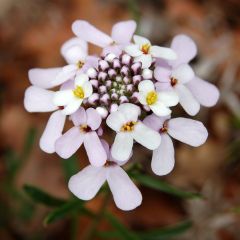
Iberis sempervirens Pink Ice
- Flowering time May to July
- Height at maturity 25 cm

Iberis umbellata Candytuft Fairy Mixed Seeds
- Flowering time July to October
- Height at maturity 20 cm
Discover other Iberis
View all →Available in 0 sizes
Available in 3 sizes
Available in 1 sizes
Available in 2 sizes
Available in 2 sizes
Available in 1 sizes
Available in 1 sizes
Available in 2 sizes
Available in 1 sizes
Available in 1 sizes
Planting Iberis
Where to plant Iberis
Choose a well-sunny spot as candytufts prefer blazing sun rather than shade. Due to their small size, these perennials are not sensitive to winds.
Drainage is important: Iberis do not tolerate excess moisture, so they will thrive in light, stony, and especially well-drained soil.
When and how to plant Iberis
The ideal planting period is from mid-September to November, although plants in buckets can be planted throughout the year, except during frost or heatwaves.
- Place the bucket in a container filled with water to thoroughly hydrate the root ball.
- Dig a hole three times the size of the root ball in all directions.
- Fill the hole so that the collar is level with the surface. Use a mixture of soil, potting compost, and gravel in equal parts.
- Place the root ball, leaving a space of 0.20 to 0.25 m in all directions, and fill in with the mixture.
- Firm the soil and then water generously.
Discover our video on how to to plant perennial plants in rockeries.
When and how to sow Iberis
To sow candytufts, two periods are possible: in March-April, under cover, or in May directly in place.
- Sow under cover in March
Sow under cover from March and transplant into individual pots as soon as the seedlings reach about ten centimetres. Start hardening them off by bringing them outside during the day, in partial shade, and bringing them back in at night. You can plant them out in mid-May, after the last frosts. Also protect them from direct sunlight at first with a crate, for example. Water regularly the following summer.
- Sow in place in May
The right time to sow in place is after late frosts. You can sow perennials, but especially the annual I. umbellata in place.
- Prepare the soil by working it to a depth of about fifteen cm, adding potting compost, compost, and gravel, especially in heavy soil.
- Break up and rake the soil.
- Sow and cover with a very fine layer of sand.
- Water with a fine spray.
- Thin out any overcrowded plants.
Again, watering should be monitored during their first summer.
In advance, you can perform a false sowing to limit the appearance of adventive plants. Prepare the ground as if you were going to sow: steps 1 and 2. Do not sow, and wait 2 to 3 weeks for the weeds to germinate. Remove these seedlings either by hand or by hoeing the surface of the soil. Then sow your Iberis to resume at step 3.
Here is a step-by-step guide for false sowing.
→ Discover our advice sheet on planting and growing Iberis in pots
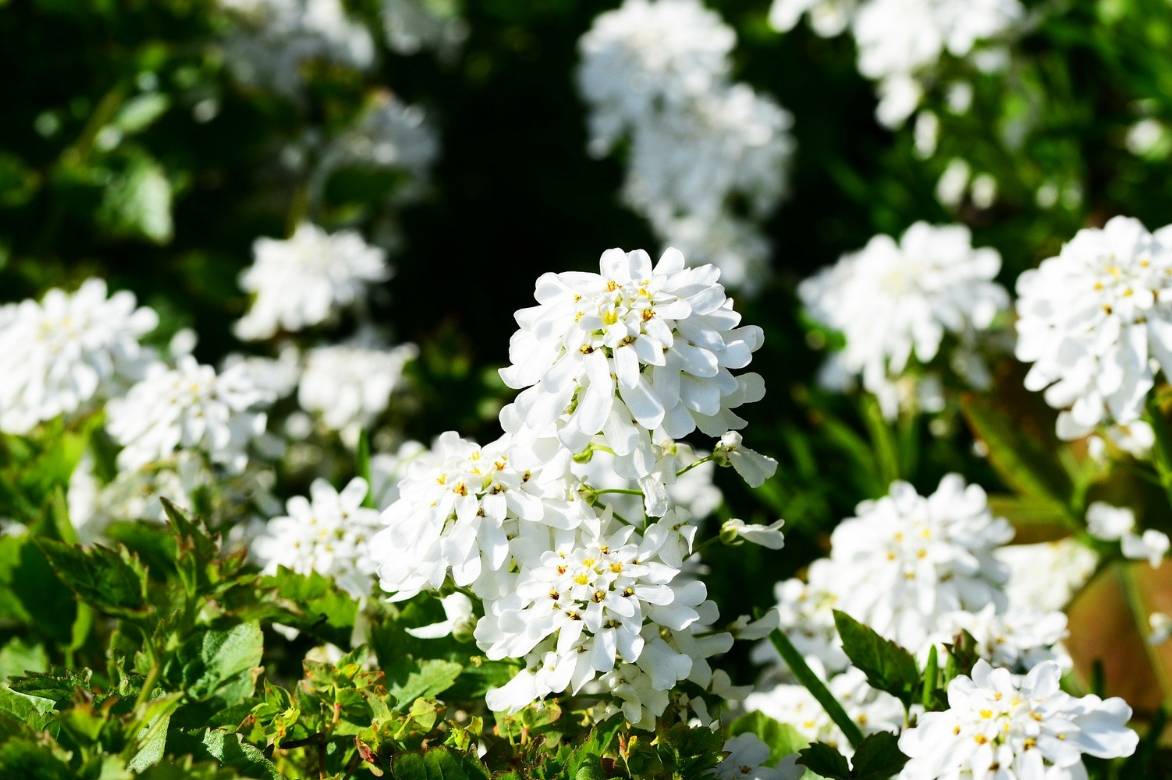
Care
Silver baskets are not demanding. The work is limited to light pruning at the end of the flowering to maintain their cushion habit, which also improves the next flowering. Removing faded flowers also prolongs the flowering. The addition of fertiliser is unnecessary, unless the iberis are grown in pots.
Diseases and Pests
Thsalpis are indestructible, especially in dry soil. They can be attacked by rust, a fungus that proliferates in high humidity. This is rarely fatal. Slugs may also target young shoots: follow these tips to get rid of them.
Propagation: sowing, cutting, division
You can multiply your silver baskets by sowing, propagation by cuttings, or division of the stumps.
Harvesting Iberis seeds
- At the end of autumn, when they reach ripeness, you can collect the seeds by gathering the clusters of faded flowers over a paper bag,
- shake the dry flower bouquets over a newspaper to air dry them, away from direct sunlight,
- store them in a cool place or outside to sow in March-April.
Propagating Thlaspi cuttings
From mid-August to mid-September, propagation by cuttings is carried out.
- Take semi-ripe shoots about 10 cm long,
- remove the leaves from the base for 4 to 5 cm,
- cut the base at an angle just above an eye,
- plant the cutting in a pot previously filled with seed and cutting compost (or a mixture of equal parts compost and sand),
- water moderately and cover with a plastic bag, a bell, or a cut bottle,
- keep at a mild temperature and out of direct sunlight,
- in spring, repot or plant directly in place.
Dividing Iberis Stumps
Choose strong and healthy plants. This should be done from mid-August to the end of September.
- Lift the clump with a fork,
- divide the tufts by hand or with a knife,
- trim the fragments to balance the root/stem volumes,
- replant these fragments immediately, either in buckets or in place,
- water generously.
Combining Iberis in the garden
For a harmony in blue, an Iberis ‘Absolutely Amethyst’ with purple flowers can adorn a planter alongside a Euphorbia ‘Black Bird’ and the collection of Ocean hyacinths.
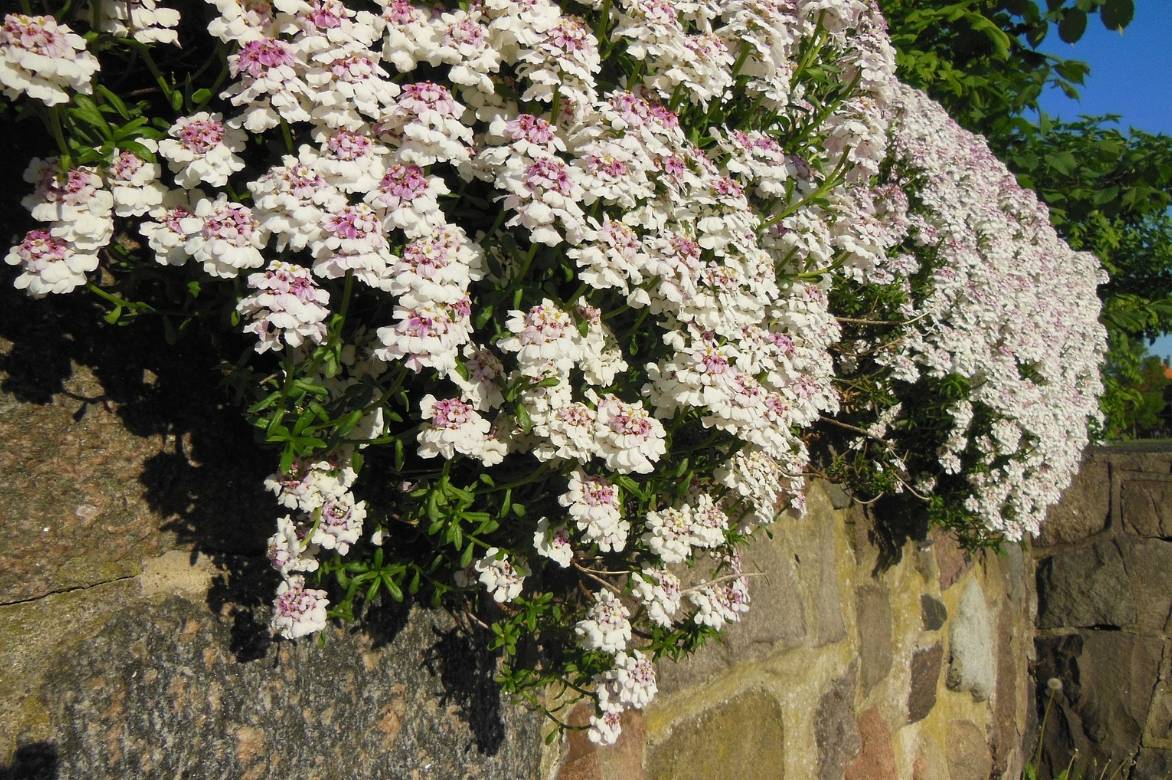
On a wall, the silver baskets create cascades of flowers.
Silver baskets are perfect for covering the bases of clematis that prefer some coolness for their roots. They can also fill the joints of paving stones in a path or terrace: helianthemums and sedums will be perfect companions.
In a flowerbed in shades of pink consisting of a Lagerstroemia ‘Mardi Gras’ as a bush that will not exceed 60 cm, are placed in front of an Iberis ‘Pink Ice’ and a dwarf peony, Paeonia humilis whose flowers are a more intense pink. The flowering, also pink, of the lovely oregano ‘Kent Beauty‘ will link the spring blooms to that of the lagerstroemia. A clump of Iris reticulata will precede the flowering of the Iberis, in February-March.

An idea for association on a sunny slope or rockery: Iberis sempervirens ‘Masterpeace’, Lithodora diffusa ‘Heavenly Blue’, Aster ericoides f. prostratus ‘Snow Flurry’, Cheilanthes lanosa (©Horticolor) and Iris reticulata ‘White Caucasus’
→ Discover more association ideas with Iberis in our advice sheet!
Useful resources
- Which plants for arid gardens will go well with the iberis you have chosen?
- What if you planted a border of silver baskets for your white flowerbed?
- Here’s a brief clarification on the main misconceptions about perennials, which include iberis.
- Advice sheet: Pairing Iberis
- Subscribe!
- Contents
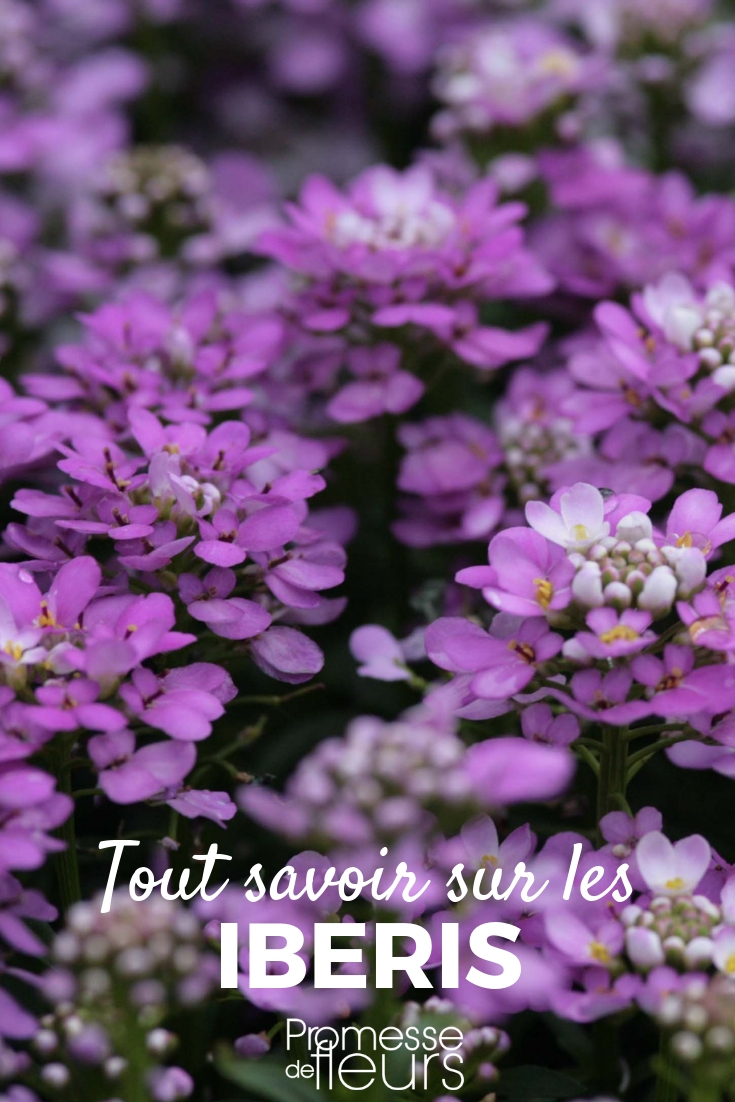

































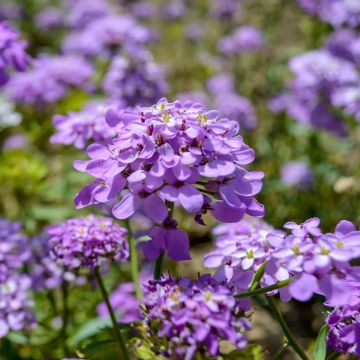
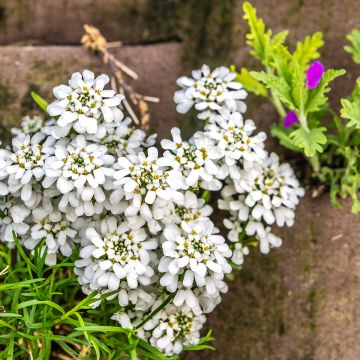



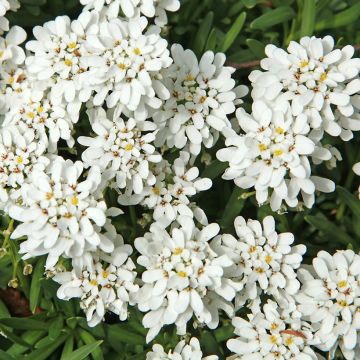
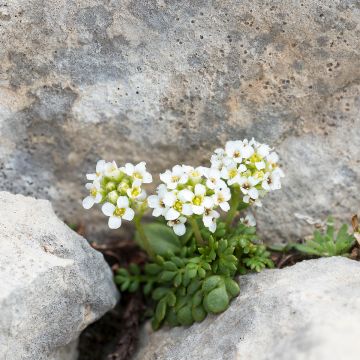

Comments